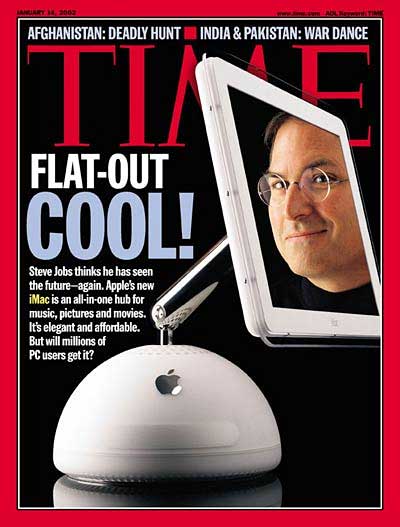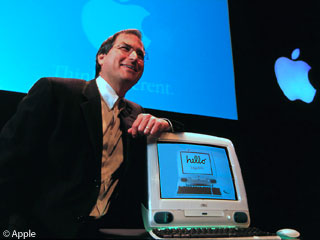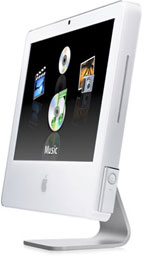This article was first published in Performance PC
Canada in November 2004.
 Even with a share of
computer sales somewhere south of 5%, Apple manages to dominate the
imaginations of the public - at least of that part of the public that
writes about technology. The January 2002 release of the company's
iMac G4, for
instance, got Apple CEO Steve Jobs on the cover of Time
magazine.
Even with a share of
computer sales somewhere south of 5%, Apple manages to dominate the
imaginations of the public - at least of that part of the public that
writes about technology. The January 2002 release of the company's
iMac G4, for
instance, got Apple CEO Steve Jobs on the cover of Time
magazine.
 Along with Jobs' influence, the original 1998 iMac, a bulbous
colourful one-piece G3-powered computer, arguably saved the company
from financial ruin and led to hordes of translucent plastic gizmos and
gadgets, everything from pens to phones trying to cash in on the iMac
look and appeal. The G4 iMac replaced the original fruity colours with
a stark white and featured an LCD panel anchored by an exquisitely
engineered arm to a distinctive semi-spherical base.
Along with Jobs' influence, the original 1998 iMac, a bulbous
colourful one-piece G3-powered computer, arguably saved the company
from financial ruin and led to hordes of translucent plastic gizmos and
gadgets, everything from pens to phones trying to cash in on the iMac
look and appeal. The G4 iMac replaced the original fruity colours with
a stark white and featured an LCD panel anchored by an exquisitely
engineered arm to a distinctive semi-spherical base.
Not everyone loved the new look, however, with critics comparing it
to an overgrown high-end desk lamp. And while initially strong, G4 iMac
sales quickly leveled off.
 Released
this September, the new
iMacs remain white one-piece, LCD-display computers, now built
around Apple's high-end G5 processor. The half-a-volleyball base of the
previous models is gone; all the computer's guts are within the LCD
screen's 4 cm thick housing. Also gone is the flexible arm; the
screen on this model tilts at different angles, but it no longer moves
forward, back, or side-to-side. The resulting look is subtler than the
earlier models: a clean, somewhat underwhelming look that should fit in
easily on desktops in homes and offices. With the 20" model weighing in
at about 10 kg (25.2 lb. - about 15 lb. lighter than the 20" G4 model), it can be
relatively easily moved about.
Released
this September, the new
iMacs remain white one-piece, LCD-display computers, now built
around Apple's high-end G5 processor. The half-a-volleyball base of the
previous models is gone; all the computer's guts are within the LCD
screen's 4 cm thick housing. Also gone is the flexible arm; the
screen on this model tilts at different angles, but it no longer moves
forward, back, or side-to-side. The resulting look is subtler than the
earlier models: a clean, somewhat underwhelming look that should fit in
easily on desktops in homes and offices. With the 20" model weighing in
at about 10 kg (25.2 lb. - about 15 lb. lighter than the 20" G4 model), it can be
relatively easily moved about.
While Apple is not the first to offer computers built into LCD
displays, most similar designs have an awkward bulge hanging off the
back of the flat panel display. Apple puts all the connectors on the
back: the power cord in the centre, the other ports in a row along the
side. There's a hole in the arm to keep cables neatly organized.
Apple's ads make it look like the system can be run virtually cable
free; the power cord is invisible from the front. If you like the
wireless look, Apple sells a Bluetooth wireless keyboard and mouse
($139), but they are not included in the basic package, nor is the
($70) Bluetooth adapter needed to make them work. If you want
Bluetooth, order it at the time of purchase: The internal Bluetooth
adapter requires a different "mid-plane" and isn't user-installable
afterwards. (Alternatively, you can use a USB Bluetooth module, but
then you've tied up one of its three USB 2.0 ports.)
Like other current Mac models, the iMac can use Apple's AirPort
Extreme 802.11g wireless networking adapter and includes an antenna for
it; like the Bluetooth adapter, the AirPort adapter ($109) isn't part
of the base package. Unlike the Bluetooth adapter, it's easily added
later. (Apple recently started to include AirPort Extreme adapters in
the base package for their iBook consumer notebooks; I hope this will
be the case for the iMacs as well).
Apple includes its standard (wired) USB white extended keyboard and
transparent optical mouse. Mac software supports multiple mouse
buttons; fans of multiple buttons can plug in most popular PC (USB)
mice and get support for right-buttons, scroll wheels, and the like.
(Alternatively, users of single-button Apple mice can access popup
context menus by holding the Control-key while clicking.) The Apple
mouse is an especially slick device whose entire body can be clicked,
but it would be nice if the company offered a two-button mouse
option.
In a tidy row along the back of the G5, users will find an audio-in
port and an audio-out port that can be used for standard headphones or
speakers or for an optical cable to connect to high-end audio gear with
SP/DIF inputs (allowing for 5.1-channel audio output). A video-out port
requires an adapter to connect to VGA or video displays. There are
three USB 2.0 ports, a pair of FireWire 400 ports, a 10/100 ethernet
port, and a modem port.
While the G4 iMacs required external speakers, the new model has
12-watt speakers built into the bottom of the display; these lack bass
response but otherwise produce pretty good sound. Also at the bottom
are air intakes; the G5 processor runs hotter than its predecessor, so
the new iMac has multiple cooling fans. The cooling system is well
designed with each fan running only as needed. Overall, the G5 iMac
runs quietly; I never noticed it over the ongoing hum of the desktop PC
sitting across the room in my office.
Another nice design touch: When not in use, the keyboard can be
stowed nicely under the display panel to take up minimal desktop space.
Alternatively, you can do away with the base entirely, mounting the
whole thing directly on a wall.
Apple is selling the G5 iMac in three configurations: Cdn$1,799 gets
you an iMac with a 17" widescreen LCD screen, a 1.6 GHz G5 processor,
an 80 GB serial ATA hard drive, a 533 MHz frontside bus, and a combo
CD-R/DVD-ROM slot-loading drive. An additional $250 boosts this to a
1.8 GHz G5, a 600 MHz frontside bus, and a SuperDrive, Apple's code for
a DVD burner. $2,499 bumps it to a large 20" widescreen display and a
160 GB hard drive. (Hard drives up to 250 GB can be ordered.)
All models include 512 K L2 cache and an 8x AGP Nvidia GeForce FX
5200 Ultra graphics chip with 64 MB DDR video memory; integrated onto
the motherboard, it is not replaceable. As well, all models ship with
256 MB of RAM. This amount of memory is adequate to run the operating
system (Mac OS X 10.3)
and basic applications, but for anything more, users will find it
highly desirable to upgrade. Apple or its dealers will happily sell you
an iMac with more RAM installed at the time of purchase; Apple upgrade
charges range from $105 for 512 MB to a hefty $1,575 for 2 GB.
Alternatively, it's fairly easy to install more RAM yourself later.
This iMac uses widely available PC-style DDR PC3200 RAM.
This iMac can be easily opened up; lay it face down on top of a
towel to avoid scratching the LCD panel. Loosen three screws along the
bottom of the display - with Apple's typical attention to detail, these
remain anchored so they can't be lost - and the back of the case comes
up. Inside, you'll find two memory slots as well as the socket for the
AirPort Extreme wireless card. The iMac can take up to 2 GB of
RAM; it can use RAM of differing sizes but will have best performance
with two identical pieces.
With the cover off, the hard drive can be upgraded or replaced and
an AirPort Express wireless card added, but that's about all that can
be done inside the box; Mac-fans wanting the ability to change video
adapters or add PCI cards will have to purchase one of Apple's Power Mac towers.
With enough RAM, the G5 iMac is a perky performer; performance is
aided by the fast SATA hard drive. Apple is among the first computer
manufacturers to make this newer, better-performing standard available
by default in some of its models. The improved hard drive bandwidth is
a big plus with applications like Virtual PC 7; finally, the
virtualized Windows system runs in something like real-time.
There's a nice software bundle: Along with the preinstalled Mac OS X
10.3, the iMac includes Apple's iLife suite (iPhoto, iTunes, iMovie,
iDVD [on systems with the SuperDrive], and GarageBand), AppleWorks
light-duty Office suite, and Quicken 2004. A 30 day-trial version of
Microsoft Office 2004 is included. If moving from an older Mac, there's
a handy Setup Assistant that will lead you through the steps to connect
your older Mac in FireWire Disk Mode, letting it appear on the iMac as
an external hard drive and making it easy to transfer documents and
settings to the new system.
Performance is good, easily outclassing the previous-generation G4
iMac on most tests and an order of magnitude more responsive than the
G4 iBook I use for most day-to-day work. It's not Apple's current
performance champ, however; for that, users will need to move to one of
the company's dual G5 Power Mac models.
It's not easy to precisely compare Macs and Windows PCs; all
comparisons are limited and too-easily criticized. Similarly, this
isn't the place for me to get into the age-old Windows vs. Mac (or
Windows vs. Linux vs. Mac) debate. Personally, I use both Windows and
Mac on a day-to-day basis.
You can buy a useable Windows PC (or even a useable Mac like
Apple's G4 eMac) for a lot
less, but if your budget can stretch to the iMac's $1,800-2,500 range
and you want a stylish, space-saving, easy to set up and use (and virus
and spyware-free) computer, Apple's new G5 iMacs are well worth a look
- even if you're currently a Windows user.
Just be sure to budget for more RAM!


 Even with a share of
computer sales somewhere south of 5%, Apple manages to dominate the
imaginations of the public - at least of that part of the public that
writes about technology. The January 2002 release of the company's
Even with a share of
computer sales somewhere south of 5%, Apple manages to dominate the
imaginations of the public - at least of that part of the public that
writes about technology. The January 2002 release of the company's
 Along with Jobs' influence, the
Along with Jobs' influence, the  Released
this September, the
Released
this September, the 
